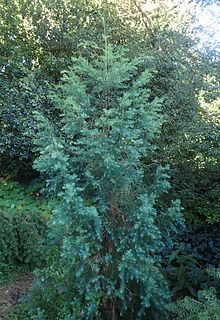Widdringtonia schwarzii
| Widdringtonia schwarzii | |
|---|---|

| |
| Scientific classification | |
| Kingdom: | Plantae |
| Clade: | Tracheophytes |
| Clade: | Gymnospermae |
| Division: | Pinophyta |
| Class: | Pinopsida |
| Order: | Cupressales |
| Family: | Cupressaceae |
| Genus: | Widdringtonia |
| Species: | W. schwarzii
|
| Binomial name | |
| Widdringtonia schwarzii (Marloth) Mast.
| |
| Synonyms[2] | |
| |
Widdringtonia schwarzii (Willowmore cedar or Willowmore cypress, Afrikaans: Baviaanskloof-seder)[3][4] is a species of Widdringtonia native to South Africa, where it is endemic to the Baviaanskloof and Kouga Mountains west of Port Elizabeth in Eastern Cape Province; it occurs on dry rocky slopes and crags at 600–1,200 m altitude. It is threatened by habitat loss, particularly by wildfire.[5][1] The Willowmore cypress is a protected tree in South Africa.[3]
It is a medium-sized evergreen tree growing to 20–25 m (formerly known to 40 m) tall. The leaves are scale-like, 1.5 mm long and 1 mm broad on small shoots, up to 10 mm long on strong-growing shoots, and arranged in opposite decussate pairs. The cones are globose to rectangular, 2–3 cm long, with four scales. It is closely related to Widdringtonia wallichii from Western Cape Province, being most easily distinguished by its larger seeds with a short seedwing.[5]
References
[edit]- Notes
- ^ a b Farjon, A. (2013). "Widdringtonia schwarzii". IUCN Red List of Threatened Species. 2013: e.T34147A2847889. doi:10.2305/IUCN.UK.2013-1.RLTS.T34147A2847889.en. Retrieved 16 November 2021.
- ^ The Plant List: A Working List of All Plant Species, retrieved 6 January 2017.
- ^ a b "Protected Trees" (PDF). Department of Water Affairs and Forestry, Republic of South Africa. 3 May 2013.
- ^ "University of the Witwatersrand: Recommended English names for trees of Southern Africa". wits.ac.za. 2006-04-28. Retrieved 2023-11-21.
- ^ a b Farjon, A. (2005). Monograph of Cupressaceae and Sciadopitys. Royal Botanic Gardens, Kew. ISBN 1-84246-068-4
- Sources
- "Widdringtonia schwarzii". PlantZAfrica.com. Archived from the original on 2008-02-18. Retrieved 2010-03-04.

